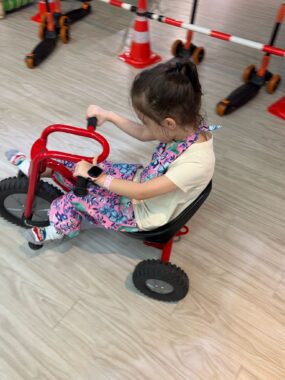After years of practice, my daughter succeeded at riding a trike
My wife and I may have laid the foundation, but we didn't unlock this moment
Written by |

For parents of children with rare diseases, progress is rarely linear. Each milestone is hard-earned, often built upon months or even years of trial, error, and perseverance.
Our daughter, Rylae-Ann, was born with aromatic l-amino acid decarboxylase (AADC) deficiency. This rare genetic disease affects neurotransmitter production, resulting in significant challenges with movement and coordination.
In the beginning, my wife, Judy, and I had a simple but big dream: We wanted to walk with Rylae-Ann.
Over time, thanks to gene therapy, that dream blossomed into something greater. Through years of therapy, persistence, and love, Rylae-Ann didn’t just learn to walk; she learned to run, climb, and even ride a scooter.
The scooter, with its straightforward push-and-go motion, came naturally to her. She zoomed over ramps, swerved around corners, and navigated bumps with ease. But one piece of equipment that remained stubbornly out of reach was the bicycle.
For more than three years, Judy and I dedicated ourselves to teaching Rylae-Ann how to pedal. It was grueling, often thankless work. Bent over for hours, we took turns holding her feet and manually guiding them in circular motions.
To complete this, we walked backward while she sat atop the stationary bike with training wheels. We did this to help her body memorize the movement. It required strength, coordination, and patience — not just from her, but from us as well. Over time, as she mastered other forms of mobility, the bike was pushed to the side.
Still, Judy and I held on to a quiet hope that Rylae-Ann would one day develop the coordination the bike required. It was never really about the bike. It was about what it represented: confidence, independence, and a new level of motor planning.
Then, something unexpected happened.
Slides and a surprise spin
Last week, Rylae-Ann’s cousin Ollie came to visit from Singapore. His parents had a short work trip in Bangkok, Thailand, and we wanted the cousins to make the most of their limited time together. Judy just so happened to feel unwell that day and called in sick. She spent the morning teaching both Rylae-Ann and Ollie at home. In the afternoon, Ollie’s dad, Otto, took the kids to a large indoor playground that Rylae-Ann and I often visit.

Rylae-Ann pedals her way around a track during an outing with her cousin and uncle. (Courtesy of Richard E. Poulin III)
They jumped in the ball pits, slid down slides, and laughed through tunnels. Eventually, they made their way to the bike track. Ollie jumped on a trike without hesitation, and Rylae-Ann followed, both of them navigating the track. Without knowing our long journey, Otto casually filmed them as they pedaled around.
When he shared the photos and videos in our family chat, Judy and I were stunned. We immediately messaged him: “Keep the camera rolling!” We were witnessing a moment that years of effort had never quite delivered. Rylae-Ann was independently pedaling a tricycle, without us guiding her feet or pushing her along.
It wasn’t us who unlocked this moment. It was her cousin. It was joy. It was play. And perhaps most importantly, it was internal motivation.
This experience reminded us of something important: As parents, especially those of children with additional needs, we often want to be the driving force behind their progress. We research, we scaffold, we support. But sometimes, we need to step back.
Children don’t always grow when we push. They grow when they’re inspired, when they feel safe, and when they’re surrounded by peers who invite them into new experiences without expectation.
The bike may have eluded us for years, but the gift of coordination, confidence, and capability was always on its way, waiting for the right moment and the right little friend to bring it out.
Note: AADC News is strictly a news and information website about the disease. It does not provide medical advice, diagnosis, or treatment. This content is not intended to be a substitute for professional medical advice, diagnosis, or treatment. Always seek the advice of your physician or other qualified health provider with any questions you may have regarding a medical condition. Never disregard professional medical advice or delay in seeking it because of something you have read on this website. The opinions expressed in this column are not those of AADC News or its parent company, Bionews, and are intended to spark discussion about issues pertaining to aromatic l-amino acid decarboxylase deficiency.





Leave a comment
Fill in the required fields to post. Your email address will not be published.